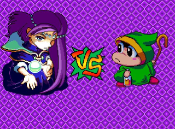I first encountered Bust-A-Move on the N64, I believe. I think there's a Wii version of the game where something like eight people can play simultaneously, sharing Wii Remote/Nun-chuk combos.
Bust-A-Move 2 and 3
Bust a move, skill to prove.
Released exactly one year apart, Bust-A-Move 2 Arcade Edition and Bust-A-Move ’99 (more commonly known as Bust-A-Move 3) are essentially the same game, with just a couple features added to 3. Like Tetris, the bubble-bursting puzzler has seen release on every system imaginable. Also like Tetris, if you’ve played one version, you’ve played them all.

As with most good puzzle games, the concept of Bust-A-Move is easy to understand, but tricky to master. The playfield is littered with dozens or sometimes hundreds of coloured bubbles which hang from the ceiling, and coloured bubbles are fired at the mass from a cannon of some sort. If a fired bubble’s colour lodges to a cluster of two or more bubbles of the same colour, they will fall off the playfield. If there are any other colours attached to the removed cluster, but not touching any remaining bubbles, they will be removed as well, scoring bonus points in the process. Shots can be ricocheted off the walls to bounce them into tough spots, so a keen eye will be key to victory.
Unfortunately, the gameplay has one mayor flaw, in the form of randomized bubbles. The colour of the bubble you are given to shoot is entirely random, which can lead to some issues when the playfield consists of a lot of different colours, with some buried above others. It’s entirely possible to receive these unreachable colours one after the other at the start of the round, and be unable to use them effectively. By the time useful colours are given, the bubble mass has already dropped a few levels, and there’s no space to clear things out. The result is a loss that feels cheap and helpless. The gameplay would flow a lot better if the player were given only colours which are touchable.

Bust-A-Move 2 features three basic modes: Puzzle, which is a series of rounds with increasing difficulty; Vs. CPU, which pits the player against various A.I. opponents; and a Vs. Player option, which is a match for two players. In addition to the modes featured in 2, 3 features a special challenge mode against CPU opponents; a serving of just over 1,000 puzzles created by various Bust-A-Move fans; and even an edit mode which allows players to construct their own puzzles. Perhaps the best new feature would be its four-player mode, which is sure to provide manic matches to no end.
The games have a couple of persistent annoyances. Because they were originally arcade games, the words “P2: Press Start” flash in the upper right corner of the screen at all times. There is also a time limit of ten seconds on every select screen besides the main menu. In 2, the quality of the sound effects is akin to a Game Boy game, and its ear-piercing screeches soon become grating. The sound in 3 has been cleaned up, but it’s still nothing remarkable.

Fans of puzzle games should at least try out Bust-A-Move, and it might even have a certain appeal to shooter fans as well. Though it’s more action-oriented than most, it can still provide fast and frantic fun. If you don’t already own a version of the game on some other system, then 3 is the way to go. There’s no reason to get 2 as 3 has everything it does, and more.






Comments